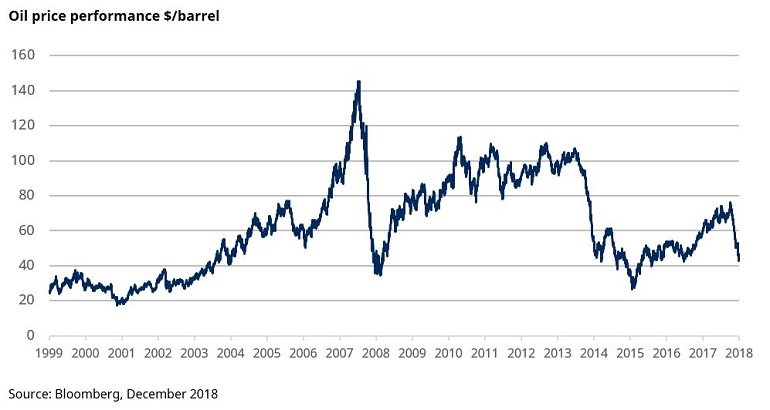Following the recent oil price plunge, Mark Lacey, Head of Commodities at Schroders, looks at the outlook for oil supply and demand in the coming year.
The ~40% fall in crude oil and gasoline prices since September is the sharpest sell-off in more than a decade.

Although we’d been relatively cautious about the crude complex in recent months, we did not expect prices to fall so far and so fast. However, we expect the supply response to lead to a very strong recovery in 2019.
In summary, our views on oil are:
- We do not expect demand to collapse in 2019.
- We think the IEA and OPEC estimates for demand are now too low for 2019. China and India oil demand could surprise on the upside.
- We do not expect North America to flood the market with oil in 2019.
- Crude oil inventories are not excessive – we expect them to rise over the next few months and then draw in Q2 and Q3.
- Total oil and product inventories are normal for this time of the year.
- Record low oil pricing at hubs in North America (Hardisty, Clearbrook and Midland) will lead to reduced volumes.
- Iran volumes will still fall to 3.2 million barrels per day (mb/day) in 2019, even with the waivers being applied (which enable some nations to keep importing Iranian oil without running afoul of US sanctions).
What caused the recent sell-off?
As far as we can tell the reasons behind the sell-off are:
- Concerns over excess oil supply in 2019 (which we think are over-blown).
- Concerns over oil demand collapsing in 2019 (we think demand will soften in 2019, but will still grow at healthy rates).
- A concern that North America will flood the oil market in 2019 with too much supply (we think this risk has been greatly reduced by regional hub pricing discounts).
- The broader sell-off seen across asset classes.
What’s the outlook for global oil demand in 2019?
Despite what many investors think, oil demand is relatively resilient, even in the event of an economic slowdown. So, to put into context our forecast for 2019 oil demand, it is important to note that oil demand in 2018 will grow at roughly 1.45 mb/day. We are conservatively forecasting demand growth of closer to 1.25 mb/day in 2019. This growth comes almost entirely from non-OECD demand, with OECD demand expected to be roughly flat in 2019.
OPEC and the IEA (after the fall in oil prices) have started to downgrade demand assumptions for 2019, driven by concern for generally weaker global GDP growth. However, we have not yet seen demand weakness coming through in the reported numbers, with recent data showing record high Chinese refinery demand and a recovery in Indian oil demand to record high imports.
We do expect emerging market currency weakness to weigh on oil demand a bit, but this negative impact will be more muted now that oil prices are at lower levels.
We also think that OPEC and IEA are underestimating demand growth from China. Our view differs from theirs because we believe Chinese oil demand growth will be driven mainly by vehicle usage trends, as opposed to industrial activity or economic growth. Personal mobility (both in terms of domestic driving and international travel) continues to be something increasingly sought after, and this means the average Chinese person is starting to use more gasoline and kerosene.
You can find out more, including Schroder’s views on supply (OPEC, non-OPEC and North American onshore), inventories, speculative positioning, and Schroder’s oil price outlook here.
This article has first been published on schroders.com.